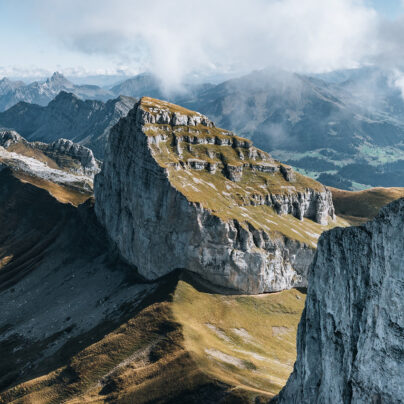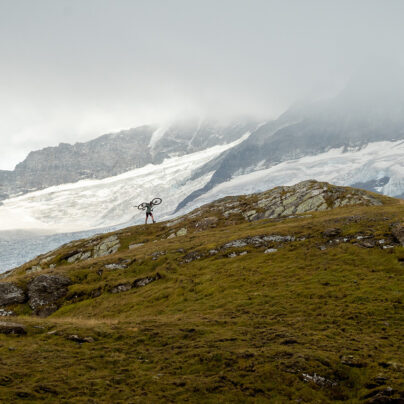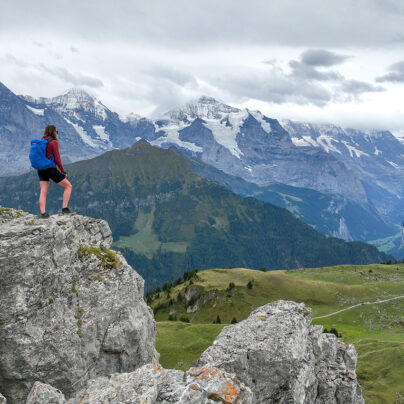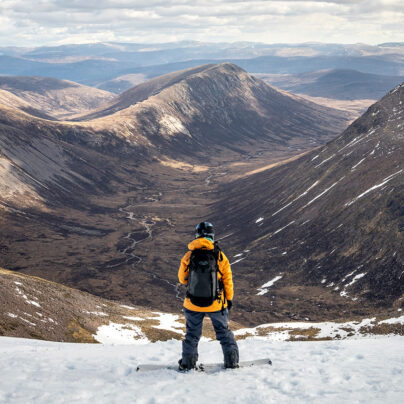Venture Out
Produced in Partnership with KEEN Footwear
Tom Hill // Photography by Johny Cook
Blinking in the spring sunlight, I pull out a map and remind myself of my idea. This loose plan will see me travel almost due south, taking in waterfalls, bothies, and the muscular Carneddau mountain range before hitching back to a train station.
There’s something calming, soporific almost, about the rhythm of a train clacking along the tracks. Were it not for the view out to sea drawing my attention I could have lost myself in daydreams for hours. I’ve always loved train travel – loved that it seems to make the journey part of the adventure in a way that driving never does. Maybe it’s because my eyes aren’t glued to the road, and I’m free to look around. This is what I am hoping for throughout this journey: simply time to enjoy where I am, without worrying too much about the route or final destination.
Next stop: Llanfairfechan. I swing my single piece of luggage over my shoulders and, a few hours after leaving Manchester’s city centre behind, step off onto a near-deserted platform on the north coast of Wales. Earlier, my day began with a map, a coffee, and endless opportunities. My finger traced along the red dashes of footpaths, as lightly and quickly as a chough, darting between potential locations. Now there’s a reassuring weight to my rucksack, which is stuffed with all the food, clothing and shelter that I’ll need for three days and two nights in the hills. Blinking in the spring sunlight, I pull out a map and remind myself of my idea. This loose plan will see me travel almost due south, taking in waterfalls, bothies, and the muscular Carneddau mountain range before hitching back to a train station.
I stride out on tarmac, anxious to feel trail underfoot, but aware that these will be the easiest-won miles of the whole trip. The sun already hangs low in the sky by the time I reach Aber Falls. The towering waterfall slowly reveals itself as I climb towards it. A bright daub of white against distant cliffs and hillside gives a sense of scale long before I am close enough to hear the roar of water, or feel the spray hanging in the air. Reaching the base, I crane my neck upwards, standing quietly as a few other sightseers scramble around the rocks that frame the torrent. This will be the last time I see another person for several hours; it never ceases to amaze me how easy it is to find solitude on our populous and crowded isle.
A vague footpath leads off to the side of the falls. Flattened grass provides the only real suggestion of a trail, followed by the hint of a line crossing a scree slope. The path takes a large ‘Z’ shape, delivering me to the top of the falls, a few horizontal metres away from where I previously stood, but 100 higher up. Beads of sweat roll down my forehead, and I can feel my thighs complaining with each footstep. I may be bearing the physical weight of carrying my life for the next few days, but my heart feels lighter. Time stretches out in front of me; I have no deadlines, no need to hurry. Even better, the end of my trip feels far enough away that I don’t even contemplate it. My focus is able to rest solely on being in the here and now. I stoop down and fill my water bottle, feeling the ice-cold stream chill my fingers instantly. When I take a swig, the frigid water instantly catches my throat and the dull ache sinks deeper as I swallow.





Climbing gently now, the footpath follows the stream Afon Goch to its source. It doesn’t take long to reach a sheepfold and remains of a small settlement, long since abandoned by its human inhabitants. A wild mountain pony greets us. Purest white, with a mane like the falls I just passed, she stands calmly as I approach – strong and squat, yet strangely elegant. The Carneddau mountain ponies have lived wild in the hills for centuries. They are susceptible to the worst of the winter weather, with only the strongest surviving through to spring. My equine companion keeps me company for a little longer, climbing above me and leading the way in front for a few hundred metres before boring of my slow progress along the heavy, tussocked ground.
***
Navigation, a how not to: the universal rule of navigating by map is your route will always straddle the sides of your map. Not only will you constantly have to flip it over, you will have to open it out in its entirety, creating an enormous sail as the wind threatens to rip it from your hands at the worst possible moment. You will then try to refold it in some kind of order, only to resort to crumpling it up and shoving it back in your pack.
***
The sun dips below the hills around the same time as I crest Foel-fras. Patches of snow linger in hollows, iridescent in the half-light of dusk. The air temperature drops quickly as darkness falls. My route takes a deliberate dog-leg above a steep drop, a fence line providing a useful handrail. My head torch casts light only as far as the gathering mountain mist in front of my face; I rely on the change in gradient to judge my position, branching west, eyes straining for a glimpse of the lake that marks the location of Dulyn bothy. It takes me a while to realise that I’ve been staring at it for some time, its inky blackness contrasting against the salt and pepper. The nothingness stirs primal fears, as does the silhouette of the cliffs that I have just skirted, and I walk a little quicker. The bothy doesn’t reveal itself until I reach the front door. The diminutive two-room building is tucked against the fellside, a shawl of heather and mountain grasses around its shoulders. I open the stiff, heavy front door and step inside.
The first two questions shared at a bothy are usually predictable: ‘Where have you come from?’ … ‘Where are you heading to?’ Conversation with my bothy-mates diversifies as the night lengthens. Stoves are lit, variations on dried pasta concocted. Chocolate and whisky (Penderyn, naturally) are shared, the fireplace stoked, and eventually chatter starts to die back as the coals do. Fatigue seems to be contagious; we all make noises about getting some sleep at the same time. I unfurl a mat in the corner of the room and climb into my comforting downy cocoon, then doze off to the sound of the wind picking up outside. During the night I stir, awoken by the rushing roar of approaching gusts, and the violent slaps against the bothy walls.
Patches of snow linger in hollows, iridescent in the half-light of dusk. The air temperature drops quickly as darkness falls. My route takes a deliberate dog-leg above a steep drop, a fence line providing a useful handrail. My head torch casts light only as far as the gathering mountain mist in front of my face.





Relief from the elements is instant. I strip off soggy layers and climb into my sleeping bag to warm up. The roar of my gas stove drowns out the creaks and groans of the trees above me, and I relish my oasis of calm while cupping my mug in both hands.
The wind hasn’t abated by daybreak. I’m torn between hiding in my sleeping bag a little longer and facing the elements as soon as I can. The weather forecast promises that conditions are only going to get worse during the day. I’m undecided on my route until I step outside and have to make a conscious effort to steady my balance in the wind. Heavy clouds already race above, and the highest tops – my original plan for the day – are hidden in the gloom. In the past, I would have stuck rigidly to my plan, relished a battle with nature. Forward progress at all costs, head down and pushing on.
***
Camp cooking, a small interlude: How to make packet porridge when camping. Fire up stove and fill pan with water. Belatedly realise the wind is blowing stronger than you realised and try and fashion a windbreak with some rocks and your rucksack. Casually half-read the instructions on the pack while you wait for the water to boil. Promptly forget them. Pour some/all of the water into the pack and stir. Roll over the top and wait for a few minutes. Weep a little bit inside when you realise you have made something closer to soup than porridge. Force yourself to consume at least a little before giving up and having chocolate for breakfast.
***
I change tack. I choose a lower option, working with the landscape instead of against it. Finding natural shelter in valleys and forests, I pass through endless microclimates. The weather changes my perception of place with disorienting speed. One moment a break in the clouds makes a remote hillside feel welcoming, and moments later the mood becomes forebodingly remote as the next rain squall passes through. As morning becomes afternoon I enter thick native woodland, impossibly vibrant despite the grey skies. Moss turns up the colour saturation levels to 11. Drystone walls are reclaimed by nature, carpeted in green. It’s hard to imagine them ever not being there, that they didn’t grow as organically as their current camouflage.
I break cover, setting my sights on my original campsite, but quickly abandon those plans as sheets of rain sweep along the valley. Back in the trees, I scan the map for flatter ground – for wider-spaced contours, just enough to put up a tent and hide from the elements. I climb the valley walls to find a shelf large enough to lie out on and rig my tent outer as a makeshift tarp, lashed to tree trunks and branches, angled against the prevailing wind.
Relief from the elements is instant. I strip off soggy layers and climb into my sleeping bag to warm up. The roar of my gas stove drowns out the creaks and groans of the trees above me, and I relish my oasis of calm while cupping my mug in both hands. It is only 4.00pm, but I am settled for the evening, happy again to feel part of nature without feeling the need to continue fighting through it. I close my eyes for a few seconds. Fine windblown rain sounds like static against tent fabric. Occasionally there’s a machine-gun volley of larger droplets shaken from the branches above me, punctuating the white noise.
Dark comes slowly in the forest – there is no noticeable sunset, just a gradual dying of light. As I drift off, I become aware that the weather has softened and calmed. I stick an arm out of my half-zipped sleeping bag and fall asleep feeling the subtlest of air movements against the back of my palm, a gentle reminder that I am outside.





The settled conditions last until morning, and, as I break camp, I run mental calculations. There is a deadline for the first time on this trip. I still have most of a day to use up, though, and I’m determined to get high and reach the summits that have framed my walk so far. Tryfan is striking for so many reasons. It rises up on the other side of Llyn Ogwen from the Carneddau, standing proud from the rolling hulk of the linked ridgeline it faces. Rock dominates the mountain’s profile, and it climbs abruptly from the valley floor, its summit barely 1km from the shores of the lake, but 600m higher.
***
Wild swimming, or why discretion is the better part of valour: When sleeping in the mountains, there is little more refreshing than a dip in a remote lake. To prepare for this, you should approach the lake, find a sheltered spot to change and walk up to the water’s edge. Dip a hand in to gauge the temperature. Swear loudly, return to your kit and continue hiking, promising to try again in the summer.
***
Tryfan is a tactile mountain. As soon as I start climbing, my hands are in contact with it as much as my feet. It is a climb in its truest sense. The easiest way up the North Ridge is graded as an easy scramble, but while I have so far sought the path of least resistance on my journey, here I find joy in choosing the more difficult lines. There is air beneath my feet, and I become absorbed in puzzle-solving; each time I am left literally grasping for a solution, a handhold presents itself and upward progress continues. For the first time since leaving the bothy, I share my environment with others. Walkers offer nods of hello and words of encouragement as we spill across the flanks of the mountain and converge at points of weakness.
I don’t pause at the summit. Instead I carry on over to find a little solitude just beyond. Lying with my back against sun-warmed rock, I’m reluctant to continue; I scan the horizon, yearning to stay high, to link into the Glyderau, to remain immersed here that bit longer. The mountain ponies I shared my first afternoon with now elicit a tinge of jealousy. I don’t want to be a visitor here; I want to continue wandering as freely as they do. Though I left Manchester only 72 hours before, I feel recharged, reawakened, and reconnected to the wildness that sits just out of reach of my everyday life. It’s hard to accept that it needs to end so soon, but I feel lucky to have such easy access to these wonderful places.
Squinting, I scan my descent route and the road far below, mentally preparing for my re-entry into the hurried constraints of the city – but thoughts of a pub lunch before the train home offer some consolation. Standing up and stretching out, I skip from one slab of rock to the next and concentrate on enjoying the last leg of the journey.
Hike fast and plan your escape in the Venture waterproof hiking shoes. KEEN Footwear makes shoes to make a difference and are taking action for a better world. Find out more about #BetterTakesAction.
Written by Tom Hill
Instagram: @24Tom
Twitter: @24Tom
Photography: Johny Cook
Instagram: @johny.cook
Twitter: @JohnyCook
Web: johnycook.com
Film by Summit Fever Media
Instagram: @sfm_films/
Twitter: @SFMFilms
Web: summitfevermedia.com
Produced in association with KEEN Footwear // @KeenEurope









